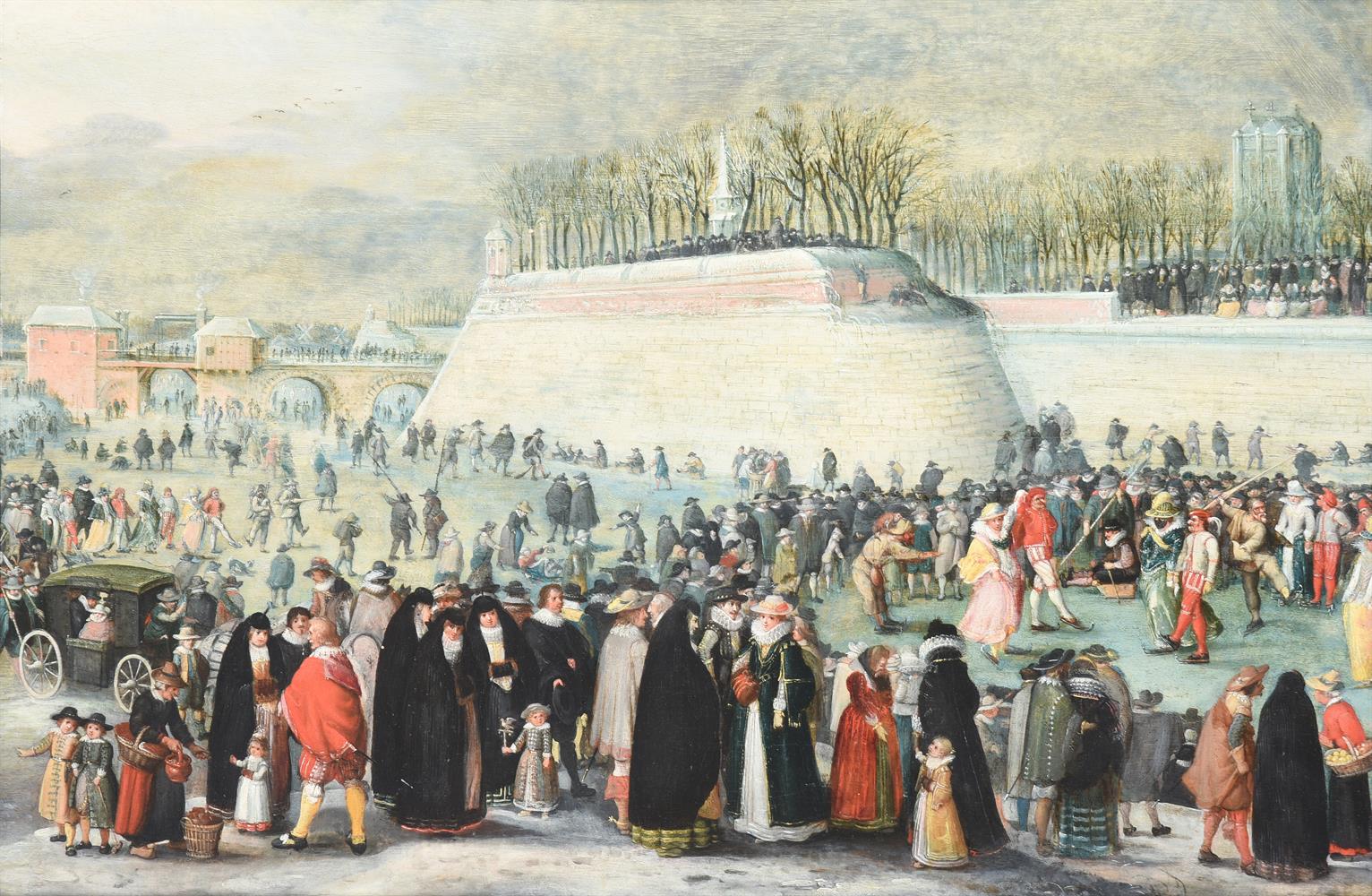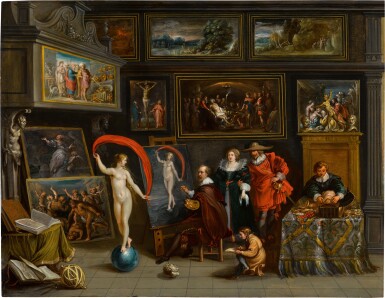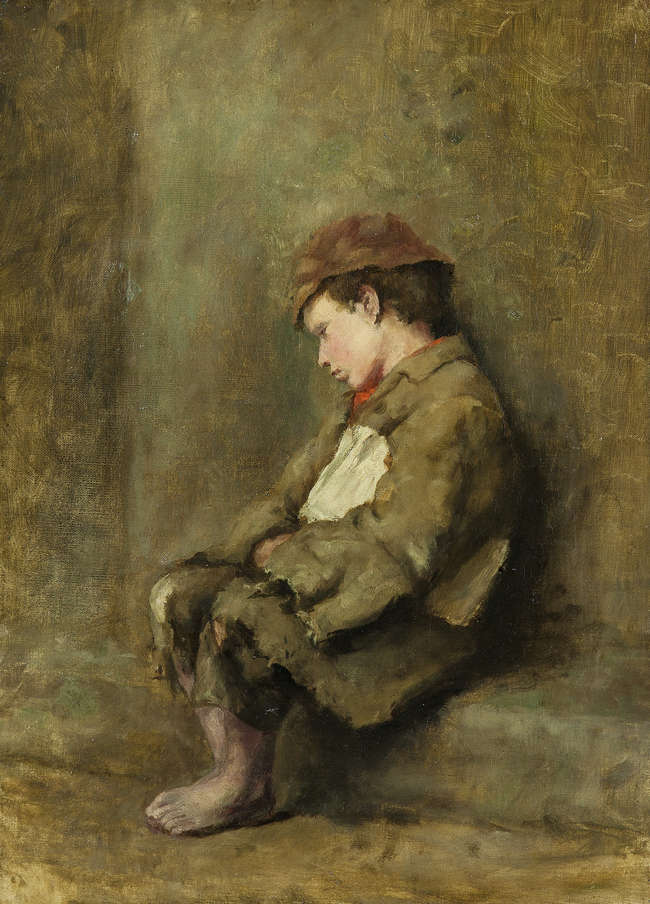Antwerp School (First Quarter 16th Century) "A Triptych: Adoration of the Magi, Nativity, and Rest on the Flight to Egypt" oil on shaped panels unsigned, left wing verso with "Carl Westenburger, Frankfurt, Germany" restorer label, ca. 1930's. In conforming frames. central panel: 29" x 20-1/2", left wing: 29" x 9-1/2", right wing: 29" x 9-1/2", overall 38-1/2" x 46-1/2" Provenance: By descent in the Kilp Family, Germany; to Antonio (1885-1959) and Carola (1895-1967) Kilp, Weisbaden, Germany; to their daughter Carmelita Kilp Blackburn (1923-2017), Sugar Land, Texas. Notes: The triptych offered in this sale, dedicated to the story of Nativity, is a fine example of the Antwerp Mannerist School. This is not to be confused with the Italian Mannerists as the two vary greatly stylistically and thematically. The central panel is devoted to the scene of the "Adoration of the Magi", which was probably the most popular of scenes executed by artists of the movement. It is flanked by the "Nativity" and "The Rest on the Flight to Egypt". This style of painting is known for its rich use of color, extravagant scenery where Gothic and Renaissance architectural elements merge unabashedly; the asymmetrical composition; lack of harmonious perspective and scale (unlike Italian Renaissance examples); lavish costuming, and unnatural source of light. "Adoration of the Magi", with its inclusion of the exotic kings bearing gifts, perfectly lends itself to this theatrical tableau, creating a sense of drama and evoking an emotional response. Writing in the mid-sixteenth century, the Portuguese painter Francisco de Hollanda recorded what he claimed was Michelangelo's opinion on the achievements of Flemish Renaissance art: "Flemish painting, slowly answered the painter, will generally speaking, please the devout better than any painting of Italy, which will never cause him to shed a tear, whereas that of Flanders will cause him to shed many… In Flanders they paint with a view to deceiving sensual vision… They paint stuffs and masonry, the green rivers and bridges, which they call landscapes, with many figures on this side and many figures on that…." Although the Northern Mannerists appeared before the Reformation of 1516, it is those same qualities described by de Hollanda that appealed to the personal form of religious expression that the Protestants encouraged. The Reformation is also most likely responsible for the emergence of new, secular themes in art such as landscapes and portraiture. Whereas in the previous century, the religious and secular comingled in devotional painting, the sixteenth century witnessed a segregation of those themes. Of course, these new artistic developments could have happened without the economic prosperity. Antwerp in the early part of the 16th century emerged as the financial and trading center of Northern Europe, surpassing Bruges. This economic climate attracted artists from all over Europe, who set up workshops and produced large quantities of personal devotional works for both local consumption and export. Albrecht Durer, visiting the city in 1520, commented in his diary on the persistent carnival atmosphere on the streets of the city, especially during the Feast of Assumption of the Virgin. He also commented on the "awesomeness" of the artists guild of St. Luke, which as all other guilds in the city, was well organized and whose records give ample testimony to the sudden influx of foreign artists. The Northern Mannerist movement lasted only a few decades, although it emerged again at the turn of the century. The 17th century saw an artistic boom due to the large workshops of the popular Peter Paul Rubens and Jacob Jordaens but as the economy began to decline toward the end of the century, Antwerp ceased to be the artistic center it once was.
In overall very good condition. Each panel with a vertical shrinkage crack, running down the length of the panel, with left and right wings displaying a few additional smaller, parallel shrinkage cracks and a central panel with an additional long shrinkage crack to the left side of the panel. Due to the heavy inconsistencies in the varnish layers, it is difficult to discern under UV light what is inpainting and what is not. Most of what appears to be inpainting does not actually fluoresce. All panels with surface soiling. Left wing: Inpainting touch-ups to Virgin's right cheek and one of the angel's foreheads. Possible inpainting to the arched architectural element. Central panel: Inpainting around the shrinkage crack, small area to the far right, and possibly to the foreground. Minor touch-ups to the Virgin's face, neck, and the folds of her fabric. Tiny touch-ups to Christ's body and face, as well as the faces and bodies of the shepherds. Right wing: An approximate 5" x 3" area of possible inpainting to the left edge and upper right quadrant. Touch-ups around the folds of the Virgin's cloak, as well as strengthening to the folds of the fabric. Older touch-ups to the Virgin's forehead. Inpainting around the shrinkage crack and possibly far right foreground. Virgin and Child are largely intact. The two exposed wings with patches and later horizontal crossbars for support en verso. Condition is commensurate with age and use.
Antwerp School (First Quarter 16th Century) "A Triptych: Adoration of the Magi, Nativity, and Rest on the Flight to Egypt" oil on shaped panels unsigned, left wing verso with "Carl Westenburger, Frankfurt, Germany" restorer label, ca. 1930's. In conforming frames. central panel: 29" x 20-1/2", left wing: 29" x 9-1/2", right wing: 29" x 9-1/2", overall 38-1/2" x 46-1/2" Provenance: By descent in the Kilp Family, Germany; to Antonio (1885-1959) and Carola (1895-1967) Kilp, Weisbaden, Germany; to their daughter Carmelita Kilp Blackburn (1923-2017), Sugar Land, Texas. Notes: The triptych offered in this sale, dedicated to the story of Nativity, is a fine example of the Antwerp Mannerist School. This is not to be confused with the Italian Mannerists as the two vary greatly stylistically and thematically. The central panel is devoted to the scene of the "Adoration of the Magi", which was probably the most popular of scenes executed by artists of the movement. It is flanked by the "Nativity" and "The Rest on the Flight to Egypt". This style of painting is known for its rich use of color, extravagant scenery where Gothic and Renaissance architectural elements merge unabashedly; the asymmetrical composition; lack of harmonious perspective and scale (unlike Italian Renaissance examples); lavish costuming, and unnatural source of light. "Adoration of the Magi", with its inclusion of the exotic kings bearing gifts, perfectly lends itself to this theatrical tableau, creating a sense of drama and evoking an emotional response. Writing in the mid-sixteenth century, the Portuguese painter Francisco de Hollanda recorded what he claimed was Michelangelo's opinion on the achievements of Flemish Renaissance art: "Flemish painting, slowly answered the painter, will generally speaking, please the devout better than any painting of Italy, which will never cause him to shed a tear, whereas that of Flanders will cause him to shed many… In Flanders they paint with a view to deceiving sensual vision… They paint stuffs and masonry, the green rivers and bridges, which they call landscapes, with many figures on this side and many figures on that…." Although the Northern Mannerists appeared before the Reformation of 1516, it is those same qualities described by de Hollanda that appealed to the personal form of religious expression that the Protestants encouraged. The Reformation is also most likely responsible for the emergence of new, secular themes in art such as landscapes and portraiture. Whereas in the previous century, the religious and secular comingled in devotional painting, the sixteenth century witnessed a segregation of those themes. Of course, these new artistic developments could have happened without the economic prosperity. Antwerp in the early part of the 16th century emerged as the financial and trading center of Northern Europe, surpassing Bruges. This economic climate attracted artists from all over Europe, who set up workshops and produced large quantities of personal devotional works for both local consumption and export. Albrecht Durer, visiting the city in 1520, commented in his diary on the persistent carnival atmosphere on the streets of the city, especially during the Feast of Assumption of the Virgin. He also commented on the "awesomeness" of the artists guild of St. Luke, which as all other guilds in the city, was well organized and whose records give ample testimony to the sudden influx of foreign artists. The Northern Mannerist movement lasted only a few decades, although it emerged again at the turn of the century. The 17th century saw an artistic boom due to the large workshops of the popular Peter Paul Rubens and Jacob Jordaens but as the economy began to decline toward the end of the century, Antwerp ceased to be the artistic center it once was.
In overall very good condition. Each panel with a vertical shrinkage crack, running down the length of the panel, with left and right wings displaying a few additional smaller, parallel shrinkage cracks and a central panel with an additional long shrinkage crack to the left side of the panel. Due to the heavy inconsistencies in the varnish layers, it is difficult to discern under UV light what is inpainting and what is not. Most of what appears to be inpainting does not actually fluoresce. All panels with surface soiling. Left wing: Inpainting touch-ups to Virgin's right cheek and one of the angel's foreheads. Possible inpainting to the arched architectural element. Central panel: Inpainting around the shrinkage crack, small area to the far right, and possibly to the foreground. Minor touch-ups to the Virgin's face, neck, and the folds of her fabric. Tiny touch-ups to Christ's body and face, as well as the faces and bodies of the shepherds. Right wing: An approximate 5" x 3" area of possible inpainting to the left edge and upper right quadrant. Touch-ups around the folds of the Virgin's cloak, as well as strengthening to the folds of the fabric. Older touch-ups to the Virgin's forehead. Inpainting around the shrinkage crack and possibly far right foreground. Virgin and Child are largely intact. The two exposed wings with patches and later horizontal crossbars for support en verso. Condition is commensurate with age and use.










Try LotSearch and its premium features for 7 days - without any costs!
Be notified automatically about new items in upcoming auctions.
Create an alert